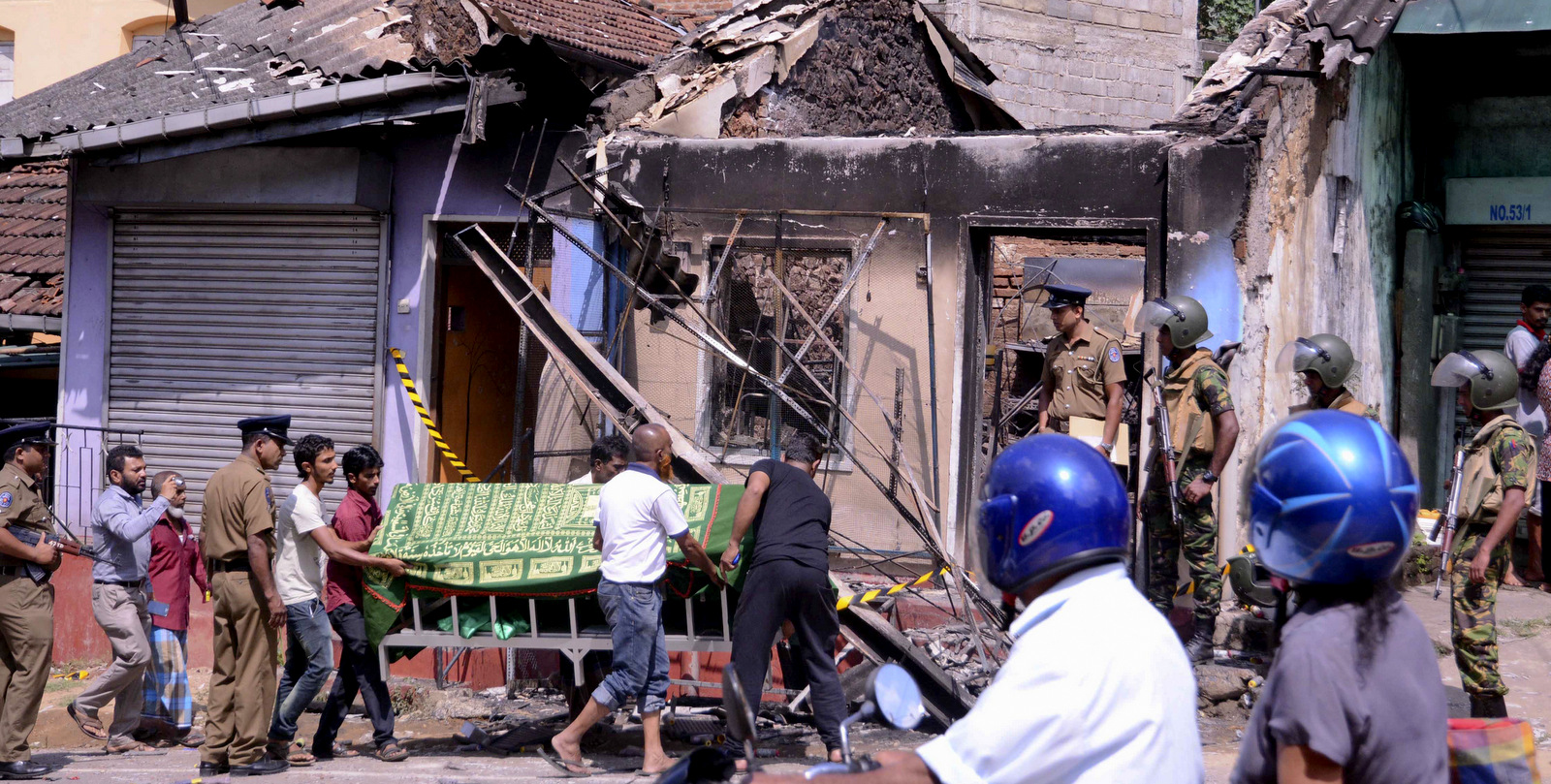On March 4th, Sinhala Buddhist mobs began sweeping through Sri Lanka’s Kandy district, hurling petrol bombs at Muslim-owned houses, shops and mosques. The attacks came as a shock, as Sri Lanka has not seen violence on this scale in nearly a decade. The government deployed thousands of security forces, armed with automatic weapons, tear gas and water cannons, but they failed to stop the violence until five days later. By then, mobs had wreaked havoc in a dozen towns and destroyed 465 properties. Yet the death toll was astonishingly low: The mobs ultimately killed just one person.
What accounts for the disparity? Dozens of ordinary civilians and local leaders used a variety of innovative strategies to protect one another and prevent violence from escalating.
Paradise in tears
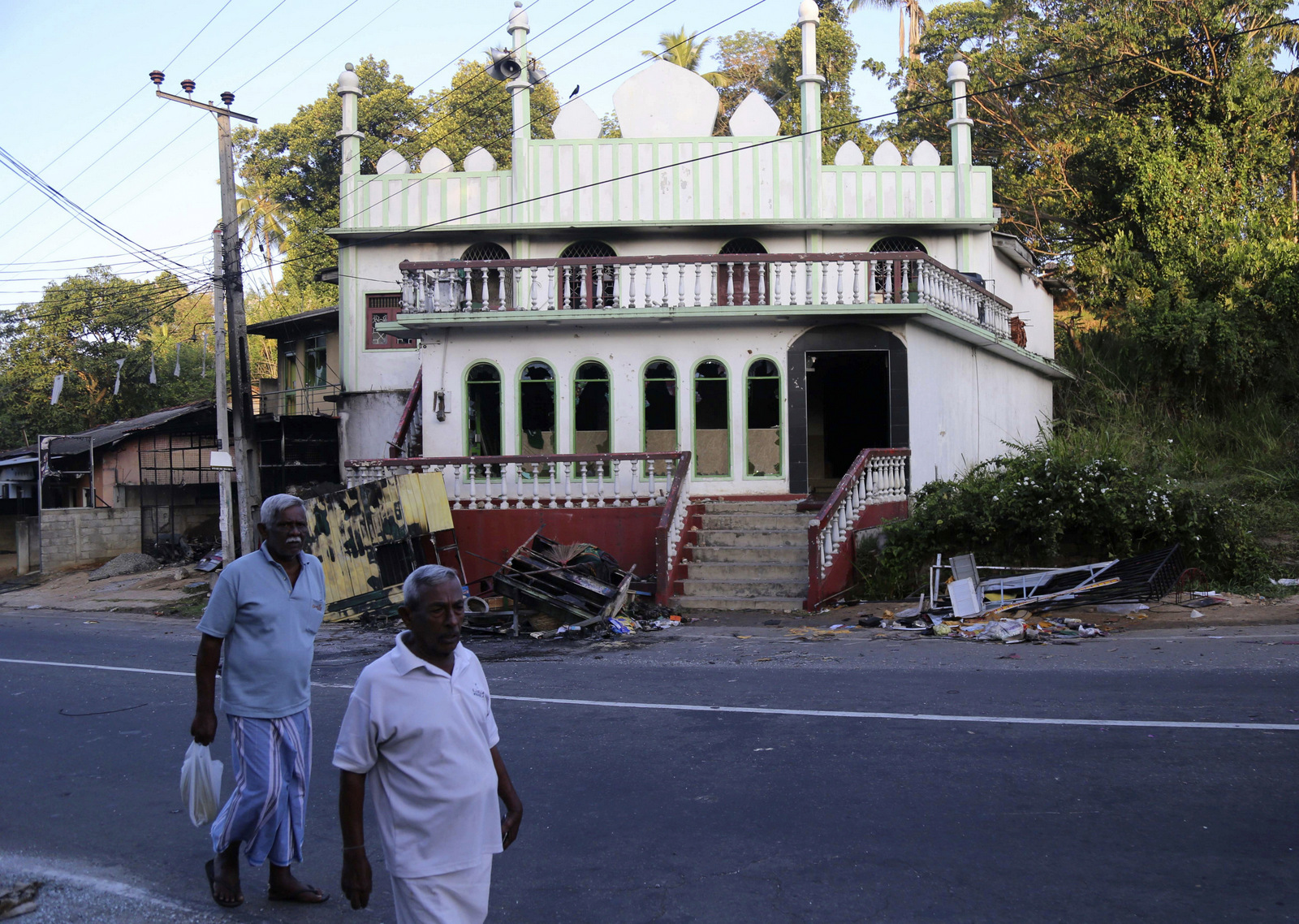
Sri Lankans walk past a vandalized Mosque in Diana, in central Sri Lanka, March 7, 2018. Sri Lanka’s president declared a state of emergency after anti-Muslim attacks in several central hill towns. (AP/Rukmal Gamage)
During Sri Lanka’s 26-year-long civil war, which ended in 2009, it was often referred to as “paradise in tears.” With pristine beaches, ancient Buddhist temples and diverse wildlife all conveniently packed into an island the size of West Virginia, the country seems like an unlikely backdrop to three decades of ethnic conflict. Since the war ended, it has become one of Asia’s top tourist destinations, but the recent violence has led many to fear that Sri Lanka could be on the brink of another war.
The situation has some parallels to Myanmar’s current Rohingya crisis: Hardliners from the majority Sinhala Buddhist population, including several monks, have engaged in a sustained propaganda campaign, using social media to spread anti-Muslim sentiments, proliferate hate speech and organize attacks. In fact, Buddhist monks organized and carried out an attack on 200 Rohingya refugees in Sri Lanka last year. But unlike in Myanmar, anti-Muslim violence is a relatively new phenomenon in Sri Lanka.
Muslims did their best to stay out of Sri Lanka’ civil war, which was fought between the Sinhala-dominated government and a separatist group from Sri Lanka’s other minority population, the Tamils. After the war ended and Tamil separatism no longer posed a threat to nationalist ideals, militant Sinhala Buddhists began to target the Muslim population instead.
Over the last five years, Sinhala Buddhist nationalists have exploited global trends in Islamophobia to bolster myths that the nine percent Muslim minority is plotting to wrest control of the country away from the Sinhala majority and transform it into an Islamic nation. Although Muslims have been over-represented in the business sector for decades, nationalists now see it as evidence that Muslims are trying to economically subjugate the Sinhala population. Rumors suggesting that Muslims are trying to stifle Sinhala population growth have become ubiquitous. Accusations that Muslim restaurants are lacing food with pills that cause permanent infertility have motivated attacks on Muslims. They became so prevalent that the government carried out tests on the food. As it turns out, the “pills” were actually just clumps of flour. Sinhala nationalists also frequently use Muslims as a scapegoat for their economic frustrations, as Muslims have traditionally been associated with Sri Lanka’s business sector.
Yet, despite the prevalence of such divisive propaganda, most Sri Lankans have refused to resort to violence. Meanwhile, Muslims have largely responded to attacks with nonviolence.
During the recent attacks, Muslims leaders used mosque loud speakers (which are normally used for the call to prayer) to urge Muslims to remain calm and refrain from retaliating. In many areas, Sinhalese and Tamils stepped in to protect Muslims, using a variety of strategies.
Early warning
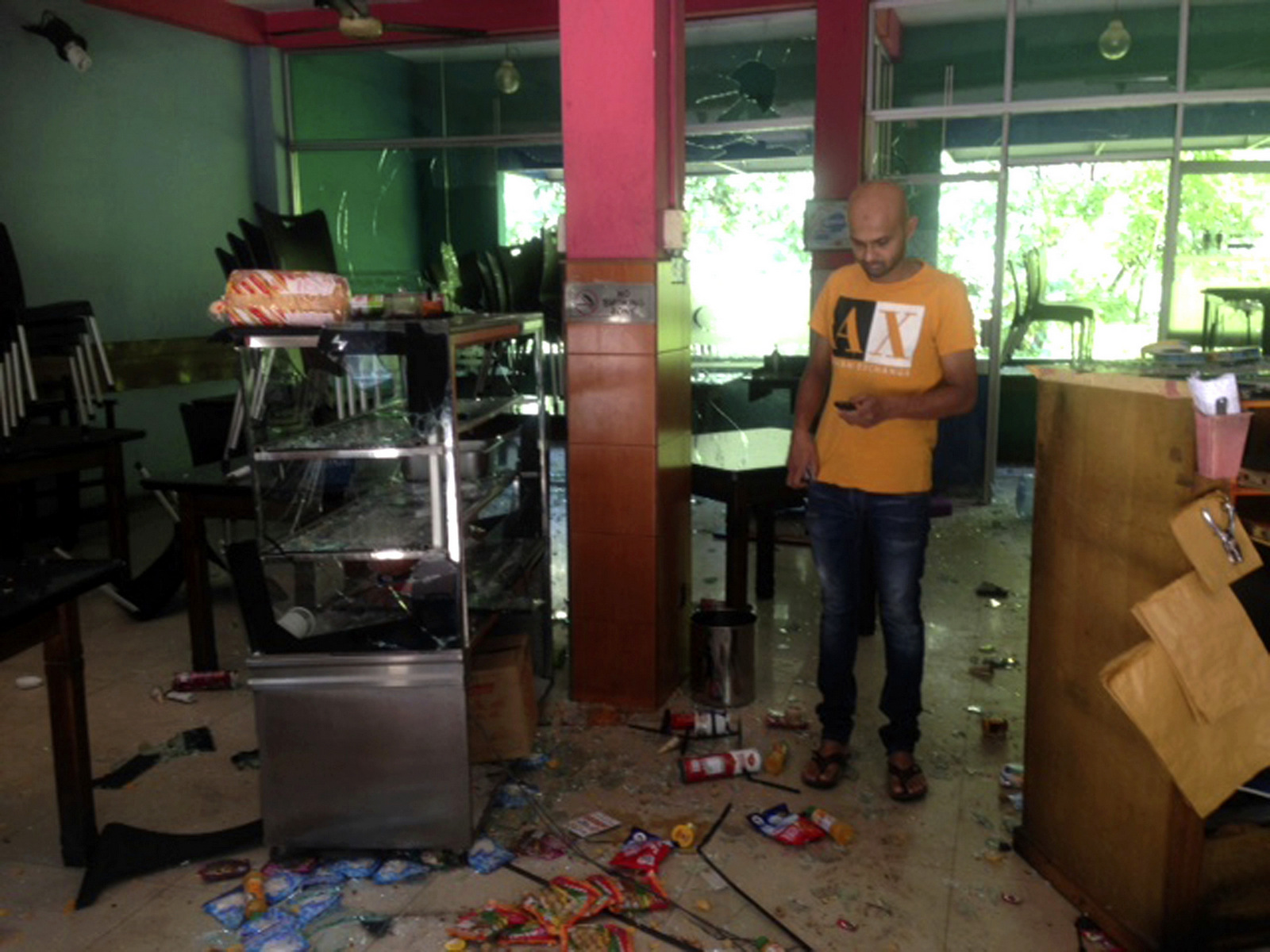
Mohamed Ramzeen makes a call from his mobile phone standing in his vandalized small restaurant in Pilimathalawa, Sri Lanka, March 8, 2018. About 50 people broke into Ramzeen’s small restaurant destroying nearly everything they found, he said. Buddhist mobs swept through Muslim neighborhoods in Sri Lanka’s central hills, destroying stores and restaurants despite a curfew, a state of emergency and a heavy deployment of security forces. (AP/Bharatha Mallawarachchi)
When a mob approached a neighborhood in the town of Pallekele, Sinhala Buddhist families called their Muslim neighbors to warn them. “We were on the way back from a wedding when the attacks began, but we turned around when our neighbors called us and told us it wasn’t safe to come home,” Hassan, a Muslim father of three explained. With their home and all of their belongings destroyed by fire, the family has been subsisting almost solely on the kindness of their neighbors who bring them food and buckets of water and charge their phones for them every day.
In Kengalla, the town that sustained the most damage in the attacks, Nussair’s friend, who had personal connections to some of the organizers of the attacks, called to warn him the day before the attacks.
“We didn’t think it was really going to happen,” Nussair said. He and his son stayed in the house, but he sent his daughter and four-month-old granddaughter out of town, just in case. Nussair and his son were still in the house when the mob began attacking it, but managed to escape. “We were so scared, we ran out the back as fast as we could,” he said.
In at least one other town, ample warning allowed Muslims to evacuate before the mobs began to attack. In a WhatsApp group that was used to organize the attacks, a group member sent a message saying “when we went to attack, there was no one, they had left,” while another member said, “someone had given them the news.”
Providing safe shelter
The mobs systematically targeted Muslim homes, shops and mosques, but other buildings remained untouched. Dozens of Sinhalese and Tamils were therefore able to provide a safe haven for Muslims during the attacks. Some hotels and families even posted invitations on Twitter.
Anyone who is affected by the incidents in #Digana #Teldeniya and doesn’t have place to stay or feels unsafe please call us on 0777 809 500. We are here to help #oneSriLanka #SriLanka #SayNoToRacism
— Polwaththa EcoLodges (@PlwthaEcoLodges) March 6, 2018
Anybody feeling unsafe in Kandy is Welcome at my home! Our doors are always open! #Kandy
— Leon (@LeonMPerumal) March 5, 2018
In one particularly organized effort, a Tamil priest went to each of his parishioners’ homes and asked them to provide shelter for Muslims. He then drove Muslim families to each parishioner’s home, where they remained for the next 48 hours. When they returned home, many found that their homes had been burned down, but the community’s actions allowed them to escape unscathed.
Violence interruption
In Rajawella, a Muslim-majority village, men decided they would defend their homes and their families when they heard the mob was heading their way. Fifty men and boys gathered at the village entrance, armed only with sticks and kitchen knives, and prepared to take on the mob of 300 people. When a local monk heard about the developing situation, he feared that it would end in a bloodbath. He came to the town, and stood in front of the men and boys when the mob began to approach. The mob saw him, stopped and retreated.
“The monk protected us. He was the only reason that we weren’t attacked,” said Hassan, a business leader from the community. Dozens of displaced Muslim families are now living at the town mosque, as it is one of the few in the area that remained unharmed.
Protective presence
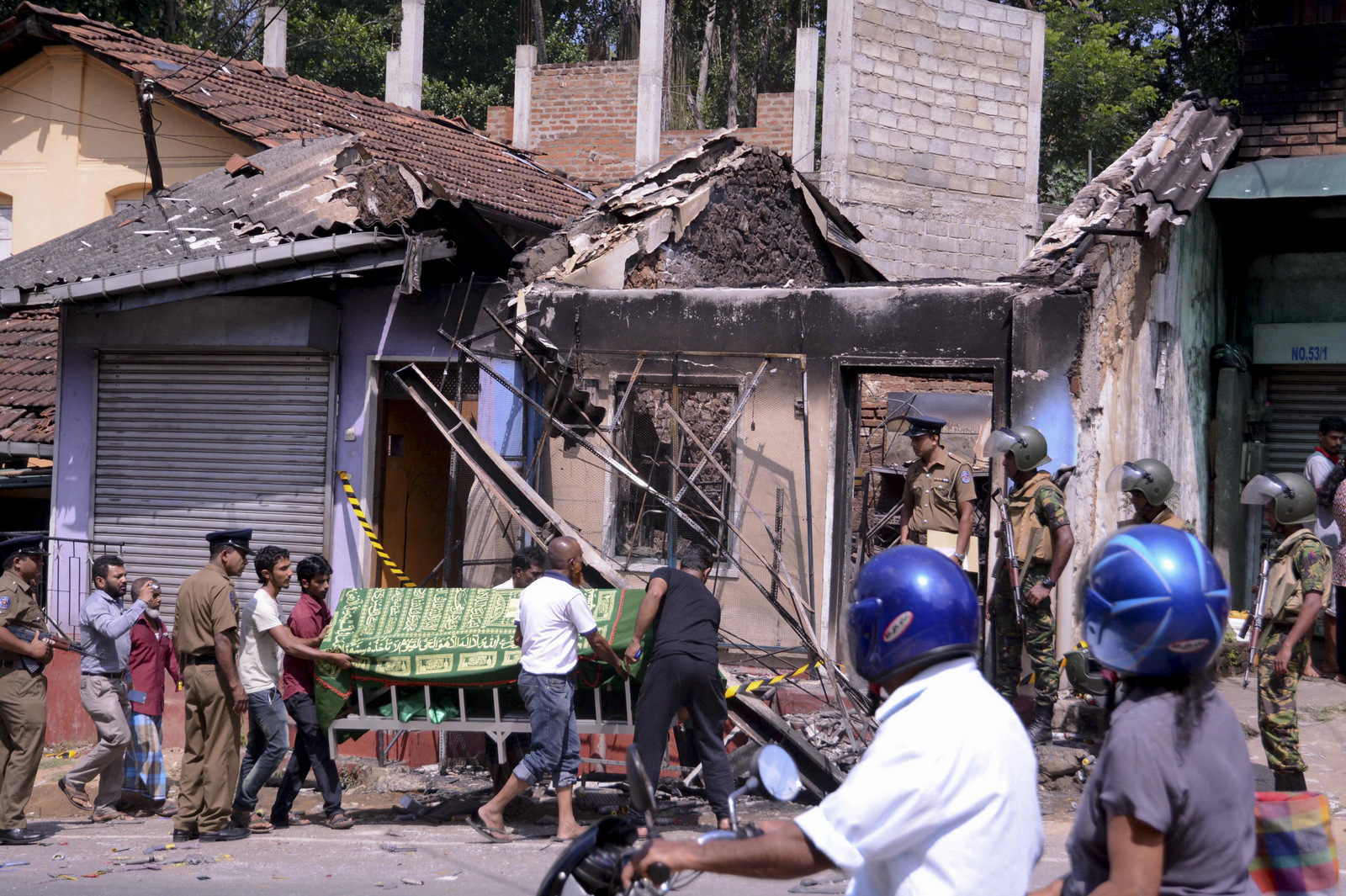
Sri Lankan police personnel stand near a vandalized building as they prepare to remove the body of a man who was killed in Digana, a suburb of Kandy, Sri Lanka, March 6, 2018. Buddhist mobs swept through the town burning at least 11 Muslim-owned shops and homes. (AP/Pradeep Pathiran)
In the town of Balagolla, the Muslim community was afraid of being attacked during Friday prayers and reached out to Ven. Thalpotha Dhammajothi Thero, a local monk, for help. In response, the monk and his welfare committee stood outside the mosque throughout the prayers to deter any perpetrators.
“When I arrived, [the Muslim leaders] invited me inside, but I told them I am here to guard the mosque”, Dhammajothi Thero said. He insisted that he stay outside so that he was visible if any attackers arrived. As the mobs were carrying out the attacks in the name of Sinhala Buddhism, he knew that they would not attack if a monk was standing in their way.
Civilians protecting civilians
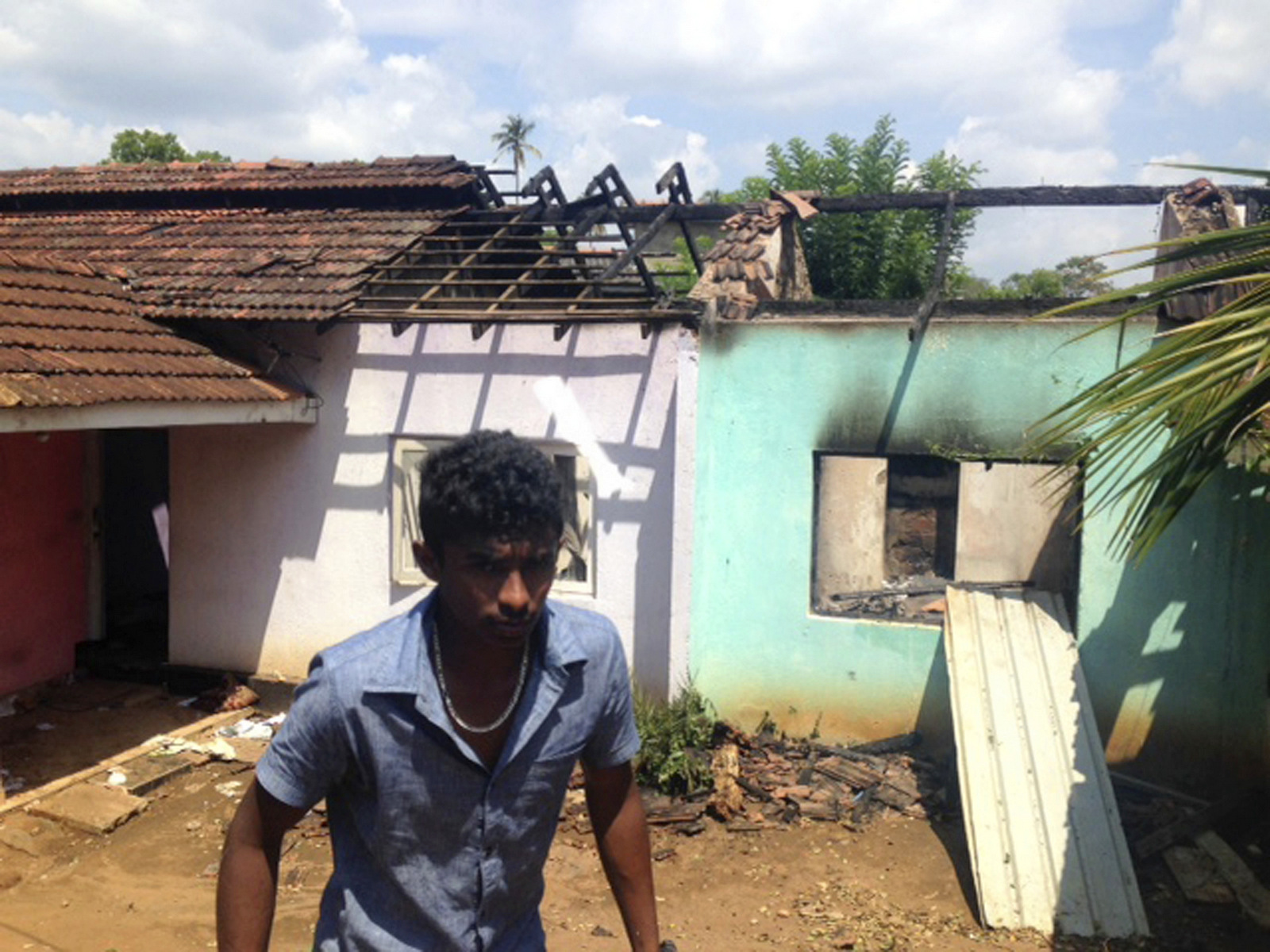
A Sri Lankan walks past a burnt house in Pallekele, Sri Lanka, March 8, 2018. (AP/Bharatha Mallawarachchi)
These interventions were remarkable, but not unprecedented. Civilians have intervened to protect each other in previous conflicts, as well. During the holocaust, Danish communities organized to warn Jews of an imminent Nazi plan to roundup and deport them to concentration camps, and then helped them escape. During the Rwandan genocide, many Hutus saved the lives of their Tutsi neighbors by providing them with safe shelter.
Additionally, civilian peacekeeping organizations such as Nonviolent Peaceforce, Peace Brigades and Cure Violence use similar strategies to systematically protect threatened civilians. For example, civilian peacekeepers deter attacks by providing visible protective presence to deter perpetrators, just as the monk in Balagolla protected the mosque during Friday prayers. Like the community members in Pallekelle, peacekeepers use early warning systems to help targeted communities flee before attackers arrive. And similar to the monk in Rajawella, they prevent clashes by interrupting imminent attacks.
In the wake of violence, the obvious response is to focus on what went wrong. But equally important is to figure out what went right. Violence is, quite literally, contagious, but so is altruism. When we see someone engage in heroic actions, we often feel inspired to take such actions. And when we help others, we feel good about ourselves and are motivated to repeat such actions in the future. By highlighting civilian peacekeeping efforts — both organic and organized — we encourage others to take similar actions in the future.
Top Photo | Sri Lankan police personnel stand near a vandalized building as they prepare to remove the body of a man who was killed in Digana, a suburb of Kandy, Sri Lanka, March 6, 2018. Buddhist mobs swept through the town burning at least 11 Muslim-owned shops and homes. (AP/Pradeep Pathiran)
Lisa Fuller spent the past eight years as a senior staff member and a civilian peacekeeper at Nonviolent Peaceforce, working in war zones such as Iraq, South Sudan, and Sri Lanka. She currently writes about civilian peacekeeping and conflict prevention.
Waging Nonviolence is licensed under a Creative Commons Attribution-NonCommercial-ShareAlike 4.0 International License.
The post How Unarmed Civilians Stopped Violent Sinhala Buddhist Mobs in Sri Lanka appeared first on MintPress News.
